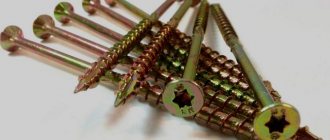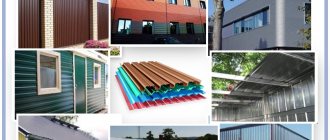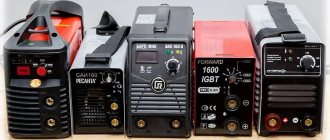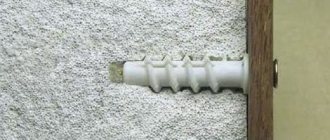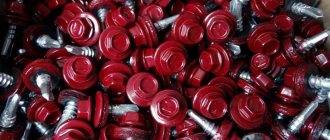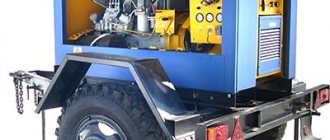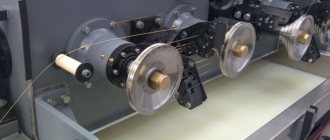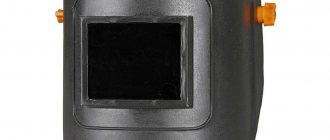In this article we will talk about the types and characteristics of self-tapping screws and help you decide on the choice of fasteners, taking into account the type of material being fastened. What is the difference between self-tapping screws, types of threads and slots?
Currently, there are a large number of fasteners on sale - anchors, dowels, etc., but the use of self-tapping screws
still relevant. The main advantage of self-tapping screws is that there is no need to pre-drill the surfaces to be fastened; using a screwdriver or screwdriver, the self-tapping screw will drill its own path. This results in a reliable fastening.
STEEL SCREWS FOR INSTALLATION OF METAL STRUCTURES SMK/SMM
Phosphated/galvanized steel self-tapping screws with a cone-shaped head for mounting metal profiles.
| Designation | Quantity per pack pcs | ~Weight kg/1000 pcs |
| SMK 3.5×9.5 drill | 1000 | 1.20 |
| SMK 3.5×11 drill | 1000 | 1.26 |
| SMK 3.5×9.5 sharp | 1000 | 1.11 |
| SMK 3.5×11 sharp | 1000 | 1.15 |
Galvanized steel (white zinc) self-tapping screws with a press washer for fastening sheet metal.
| Designation | Quantity per pack pcs | ~ Weight kg/1000 pcs |
| SMM 4.2×13 drill | 1000 | 1.80 |
| SMM 4.2×16 drill | 1000 | 2.00 |
| SMM 4.2×19 drill | 1000 | 2.06 |
| SMM 4.2×25 drill | 1000 | 2.63 |
| SMM 4.2×32 drill | 1000 | 3.08 |
| SMM 4.2×38 drill | 500 | 3.28 |
| SMM 4. 2×41 drill | 500 | 3.42 |
| SMM 4.2×50 drill | 500 | 4.27 |
| SMM 4.2×57 drill | 500 | 4.72 |
| SMM 4.2×75 drill | 500 | 5.60 |
| SMM 4. 2×13 sharp. | 1000 | 1.72 |
| SMM 4. 2×16 sharp. | 1000 | 1.84 |
| SMM 4. 2×19 sharp. | 1000 | 2.06 |
| SMM 4.2×25 sharp. | 1000 | 2.55 |
| SMM 4. 2×32 sharp. | 1000 | 2.92 |
| SMM 4. 2×38 sharp. | 500 | 3.28 |
| SMM 4. 2×41 sharps | 500 | 3.42 |
| SMM 4. 2×50 sharp. | 500 | 4.27 |
| SMM 4.2×57 sharp. | 500 | 4.72 |
| SMM 4.2×75 sharp. | 500 | 5.51 |
Types of self-tapping screw heads
High-quality self-tapping screws are distinguished by types of heads:
A self-tapping screw with a hex head can be produced either with a molded press washer or with a stacked washer. The hexagon is screwed in with a regular key;
With a countersunk head, thanks to which, after screwing in, the fastener is completely recessed into the surface;
A self-tapping screw with a hemispherical head, which, as a rule, remains on the surface, but if necessary, it is recessed;
For fastening fragile materials, fasteners with a hemispherical head equipped with a press washer, as well as a head with an enlarged press washer, are used.
PHOSPHATED SCREWS FOR FASTENING GYPSUM CARDBOARD SHEETS
Phosphated steel self-tapping screws with double-thread for mounting plasterboard sheets on metal bases. SGM
| Designation | Quantity per pack pcs | ~ Weight kg/1000 pcs |
| SGM 3.5×16 | 1000 | 1.05 |
| SGM 3.5×19 | 1000 | 1.15 |
| SGM 3.5×25 | 1000 | 1.35 |
| SGM 3.5×32 | 1000 | 1.63 |
| SGM 3.5×35 | 1000 | 1.76 |
| SGM 3.5×41 | 1000 | 2.03 |
| SGM 3.5×45 | 1000 | 2.19 |
| SGM 3.5×51 | 1000 | 2.44 |
| SGM 3.5×55 | 500 | 2.70 |
| SGM 4.2×65 | 500 | 3.58 |
| SGM 4.2×75 | 250 | 4.93 |
| SGM 4.2×90 | 250 | 8.40 |
| SGM 4.8×100 | 250 | 9.17 |
| SGM 4.8×110 | 200 | 9.02 |
| SGM 4.8×120 | 200 | 9.11 |
| SGM 4.8×127 | 200 | 9.17 |
| SGM 4.8×130 | 200 | 9.25 |
Phosphated steel screws for mounting plasterboard sheets on wooden bases. SRS
| Designation | Quantity per pack pcs | ~Weight kg/1000 pcs |
| SRS 3.5×16 | 1000 | 1.05 |
| SRS 3.5×19 | 1000 | 1.15 |
| SRS 3.5×25 | 1000 | 1.35 |
| SRS 3.5×32 | 1000 | 1.63 |
| SRS 3.5×35 | 1000 | 1.76 |
| SRS 3.5×41 | 1000 | 2.03 |
| SRS 3.5×45 | 1000 | 2.19 |
| SRS 3.5×51 | 1000 | 2.44 |
| SRS 3.5×55 | 500 | 2.70 |
| SRS 4.2×65 | 500 | 3.58 |
| SRS 4.2×70 | 250 | 4.45 |
| SRS 4.2×75 | 250 | 4.93 |
| SRS 4.8×90 | 250 | 8.40 |
| SRS 4.8×100 | 250 | 9.17 |
| SRS 4.8×1 10 | 250 | 9.82 |
| SRS 4.8×120 | 250 | 10.48 |
| SRS 4.8×127 | 250 | 1 1.46 |
| SRS 4.8×130 | 100 | 11.46 |
| SRS 4.8×150 | 100 | 13.50 |
Differences in self-tapping screws by design and material of manufacture
The full name of the self-tapping screw is self-tapping screw. It differs from a regular screw in that it does not require pre-drilling a hole. Thanks to the high thread with sharp edges, the self-tapping screw cuts turns itself, plunging into the material, acting as a drill. This technology saves a lot of time, which is why self-tapping screws are one of the most common types of fasteners.
Structurally, the self-tapping screw consists of the following elements:
- cutting tip;
- rod defining the length;
- thread that secures fixation in the material;
- a head for supporting the outside and pressing other parts;
- slot - a recess for working with a tool and screwing in the fastener.
1. Spline. 2. Head. 3. Rod.
4. Carving. 5. Tip.
There are three types of metal from which self-tapping screws are made. There are also several options for protective coating. By configuration, fasteners are classified based on splines, heads, threads, and tips. Let's consider each characteristic separately.
Self-tapping screw heads
There are several dozen types of heads. The reliability of fastening of parts or aesthetics sometimes depend on their shape. The most common of them are the following seven options.
Countersunk fastener
The element is completely flat on top, and the transition to the rod is made in the form of a cone. When wrapped, the part is completely immersed in the material and does not stick out from the outside. This is the most common version of the self-tapping screw head, which has a wide range of applications.
Self-tapping screws with press washer
It has a flat cast washer connected together with the head. Due to the increased area, it reliably presses thin wooden slats or metal sheets.
Semi-countersunk head
A bit similar to the one described above, but has a small protrusion on top. The cone itself is larger, so increased force is required when wrapping. Used for fastening profiled sheets or even thin metal.
Semicircular head
The top is endowed with a spherical shape. Due to the absence of right angles, other materials do not cling to it. Designed for assembling equipment bodies, machine tools, and car parts.
Hex head
It has a cast washer and a hexagonal projection on the outside. It is tightened using a wrench or socket head, not a screwdriver. Suitable for fastening large objects. When combined with a self-tapping screw and dowel, it can be securely placed in concrete.
Cylindrical head
On the outside it is endowed with a smooth cylinder without edges. All splines are inside the head. To install the self-tapping screw, you will need to pre-drill a hole. But a neat appearance provides aesthetics. Fasteners are used to fix roofing materials, wood slats, thin metal sheets and panels.
Anti-vandal head
The self-tapping screw head is made with complex-shaped slots, which require a special tool. You won't be able to unscrew it normally. Hardware is used in publicly accessible places for fixing signs, license plates, and assembling equipment bodies.
Self-tapping slots
The recesses in the head for transmitting torque are called splines. There are a large number of varieties of slots, but only five types are most often used for self-tapping screws. Depending on the slot configuration, you need to select a bit, screwdriver or wrench.
Straight spline
One groove is made in the head, dividing the circle in half. This is the oldest type of slot, but today it is gradually being abandoned because it does not secure a screwdriver or bit well and quickly breaks from the tool, after which it becomes problematic to unscrew the fastener.
Phillips - PH
The shape of the slots is made in the form of the intersection of two straight lines. When screwing, the tool attachment acts on four sides at once, so screwing occurs much faster.
When installing 4-5 screws, it is difficult to notice such a difference, but during extensive installation work, where 100-200 hardware is needed, the time savings will be obvious. A type of Phillips screws can be designated by the letter H, which is similar to PH.
Phillips slot Pz
In addition to Pz, it can be designated as Z. In addition to the main cross-shaped slots, it has additional ones made at 45 degrees between them. As a result, this gives 8 faces for impact and prevents the tool from breaking.
Internal hexagon
To tighten it, you need a hex bit or a wrench. The model is rarely used in construction, but is widely used in furniture products.
Torx
Inside the head there are cutouts in the shape of a six-pointed star. To screw in, use a bit or a counter-shaped key. Equal size of all six beams provides better impact on fasteners and torque transmission. Torx is superior to all other types of splines in terms of screwing reliability. Self-tapping screws are used in technology, cars, power tools, mobile phones, etc.
Nuances of choice
When choosing self-tapping screws according to the type of spline, it is worth considering the size range. For example, in the cross-shaped type Ph it ranges from 0 to 4. The same range is in Pz. In the case of Torx, the size varies from 2 to 100. Incorrectly selected spline sizes will make work inconvenient and can lead to damage to the screw or tool equipment.
Types of threads of self-tapping screws
Types of self-tapping screws differ in thread configuration, which affects the ability to penetrate materials and connect them together. The difference lies in the pitch of the turns, the angle of the apex and the diameter. The smaller the angle of the apex, the easier it is to tighten the self-tapping screw, since the turns will be sharper.
For example, for chipboard, plasterboard or wood, the 45º standard is used. Installation of fasteners does not require pre-drilling, and threads are easy to cut. But the smaller the angle, the thinner the top, and therefore less durable. Therefore, for dense materials, an increased angle is used. For example, for concrete and metal, a vertex angle of 60º is suitable.
The configuration of the turns is divided according to frequency, as well as the shape of the arrangement, into the following types:
1. Rare thread - used for porous or soft base materials, such as chipboard, plaster, wood.
2. Medium thread - is universal, but is more often used for brick or concrete. Applicable for sandwich panels.
3. Frequent thread - suitable for dense materials with increased hardness. It can be metals, wood (oak, ash, beech), plastic.
4. Asymmetrical - ensures easy wrapping in materials of different hardness, since the coils are located with different heights and bulging sides. Most often, such fasteners are used for gypsum fiber sheets.
Self-tapping screw tips
There are five tip shape options, each of which is effective in its own way when wrapping materials of different densities:
1. Sharp - the sharpening angle of the end is 20-30º. For ordinary screws, this parameter is 40 degrees, so sharp self-tapping screws are excellent for screwing into plaster, soft wood, plastic or thin sheets of metal.
2. Sharp with a cutting edge - similar to the fastener described above, but with an additional edge that speeds up the cutting of the surface.
3. Tip-drill - special edges at the end act as a drill, drilling through the material. There are 6 types of this tip in length. Suitable for wrapping in dense materials - concrete and thick metal.
4. Drill with wings - an improved analogue of the screw described above, but with added petals on the sides of the threaded part. They break up the drilled hole, making it easier to insert the turns.
Material of manufacture
The raw materials from which self-tapping screws are poured affect the cost of the products, their durability, strength and resistance to moisture. Although many alloys can be used, the most common are the following three:
- Carbon steel is simply iron with carbon added to make it harder. Self-tapping screws are inexpensive, can be bought anywhere, and are suitable for lightweight structures, such as fixing drywall, assembling wooden shelving, etc.
- Stainless steel is iron alloyed with chromium, nickel and other additives that increase corrosion protection. Due to this, the viscosity of the metal also increases, making the fastener resistant to increased shear or rupture loads. An expensive type of hardware is used in wet areas or in medical equipment.
- Brass alloy - tin and copper are added to iron. The material is resistant to corrosion and tolerates negative temperatures well. Suitable for fixing materials in damp rooms or on surfaces in contact with shoe soles (for example, attaching linoleum thresholds to a wooden floor).
Type of protective coating
In addition to the alloy of the screw itself, they differ in the material of the protective coating. Depending on the composition, it may affect the following characteristics and properties:
- surface wear resistance;
- magnetization;
- heat conductivity;
- electrical insulation;
- electrical conductivity;
- absorption of light or reflection.
Let's look at the most common types of coating for self-tapping screws and their areas of application.
Phosphated screws
The most affordable type of self-tapping screws. By coating the outer part with phosphates, the result is a matte black tint. This slightly protects against corrosion, but in a humid environment the fasteners quickly become covered with rust and form red streaks. Suitable for metal and wood, as well as plaster, but in dry rooms. Not recommended for outdoor use without protection from precipitation.
Oxidized screws
Also black, but with a glossy surface, making them easy to distinguish from the previous ones. The oxide forms a protective film on the outside, increasing protection against corrosion. The scope of application is similar to conventional black self-tapping screws, but their service life is longer.
Chrome plated
Available in high carbon or stainless steel and coated with chrome on the outside. For this purpose, chromic acid treatment technology is used. Thanks to this, they do not rust and are highly resistant to scratches, abrasions and chips.
High-strength elements are suitable for fixing heavy parts in critical structures. Due to their beautiful appearance, they are widely used on facade elements and the front side of furniture.
Galvanized screws
Covered with a layer of zinc on top. Because of this, the surface gets a silvery or yellowish tint. Spraying protects against moisture until it wears off. If the fastener is not subject to mechanical abrasion, it will last a long time even in a damp environment.
Yellow-passivated
Self-tapping screws are processed using a combined technology, where after galvanizing an additional layer of chrome is applied. Double protection is recognized by its yellow color. The product is suitable for outdoor use.
When choosing a self-tapping screw coating, it is important to focus on its ability to work in a humid environment. Knowing the shade options will also help you choose the right color for stylistic unity. For example, in furniture production, yellow screws are often used so that they blend better with the wood.
UNIVERSAL HARDENED SCREWS SG
Universal galvanized steel (yellow/white) self-tapping screws for fastening various structures to wood, plywood, chipboard. When using a dowel, it is applied to dense materials.
| Designation | Quantity per package pcs | ~Weight kg/1000 pcs |
| 5С 2.5×10 | 50000 | 0.28 |
| 5С 2.5×12 | 50000 | 0.31 |
| 5С 2.5×16 | 40000 | 0.38 |
| 5С 2.5×18 | 36000 | 0.42 |
| 5С 2.5×20 | 36000 | 0.47 |
| 5С 2.5×25 | 24000 | 0.58 |
| 50 3.0×10 | 60000 | 0.42 |
| 50 3.0×12 | 50000 | 0.50 |
| 50 3.0×16 | 40000 | 0.57 |
| 50 3.0×20 | 35000 | 0.72 |
| 50 3.0×25 | 25000 | 0.82 |
| 50 3.0×30 | 18000 | 0.95 |
| 50 3.0×35 | 15 000 | 1.02 |
| 50 3.0×40 | 11 000 | 1.10 |
| 50 3.5×12 | 30 000 | 0.80 |
| 50 3.5×16 | 24000 | 0.90 |
| 50 3.5×20 | 18 000 | 0.95 |
| 50 3.5×25 | 16000 | 1.05 |
| 50 3.5×30 | 12000 | 1.28 |
| 50 3.5×35 | 10000 | 1.45 |
| 50 3.5×40 | 8 000 | 1.63 |
| 50 3.5×45 | 6500 | 1.90 |
| 50 3.5×50 | 5 500 | 1.98 |
| 504.0×12 | 25000 | 0.98 |
| 504.0×16 | 20000 | 1.00 |
| 504.0×20 | 17000 | 1.15 |
| 504.0×25 | 14000 | 1.43 |
| 504.0×30 | 12000 | 1.56 |
| 504.0×35 | 10000 | 1.87 |
| 504.0×40 | 8000 | 2.07 |
| 504.0×45 | 6500 | 2.40 |
| 504.0×50 | 5 500 | 2.56 |
| 504.0×55 | 5000 | 3.06 |
| 504.0×60 | 4500 | 3.57 |
| 504.0×70 | 3 500 | 3.60 |
| 50 4.0×80 | 4000 | 3.75 |
| 504.5×16 | 18000 | 1.35 |
| 50 4.5×20 | 13 000 | 1.60 |
| 504.5×25 | 10000 | 1.90 |
| 50 4.5×30 | 8 500 | 2.15 |
| 504.5×35 | 7500 | 2.43 |
| Designation | Quantity per package pcs | ~Weight kg/1000 pcs |
| 504.5×40 | 6500 | 2.94 |
| 504.5×45 | 5 500 | 3.32 |
| 504.5×50 | 5000 | 3.70 |
| 504.5×55 | 4000 | 4.08 |
| 504.5×60 | 3 500 | 4.46 |
| 504.5×70 | 3000 | 5.22 |
| 504.5×80 | 2000 | 5.25 |
| 50 5.0×16 | 10000 | 1.95 |
| 50 5.0×20 | 10000 | 2.05 |
| 50 5.0×25 | 8000 | 2.15 |
| 50 5.0×30 | 6000 | 2.71 |
| 50 5.0×35 | 5 500 | 3.20 |
| 50 5.0×40 | 5 000 | 3.58 |
| 50 5.0×45 | 4500 | 3.96 |
| 50 5.0×50 | 4000 | 4.34 |
| 50 5.0×55 | 3000 | 4.72 |
| 50 5.0×60 | 3 000 | 5.10 |
| 50 5.0×70 | 2 500 | 5.86 |
| 50 5.0×80 | 1 800 | 6.62 |
| 50 5.0×90 | 1 500 | 7.38 |
| 50 5.0×100 | 1 200 | 8.20 |
| 50 5.0×120 | 1 000 | 9.40 |
| 50 6.0×30 | 5 000 | 5.33 |
| 50 6.0×40 | 3 500 | 5.36 |
| 50 6.0×45 | 3200 | 5.53 |
| 50 6.0×50 | 2500 | 6.56 |
| 50 6.0×55 | 1 800 | 7.16 |
| 50 6.0×60 | 1 800 | 7.77 |
| 50 6.0×70 | 1 500 | 8.98 |
| 50 6.0×80 | 1 300 | 10.19 |
| 50 6.0×90 | 1 100 | 11.40 |
| 50 6.0×100 | 1 000 | 12.61 |
| 50 6.0×110 | 1 000 | 13.42 |
| 50 6.0×120 | 1 000 | 15.03 |
| 50 6.0×130 | 1 000 | 17.00 |
| 50 6.0×140 | 1 000 | 18.80 |
| 50 6.0×150 | 1 000 | 20.10 |
| 50 6.0×160 | 900 | 20.30 |
| 50 6.0×170 | 900 | 20.50 |
| 50 6.0×180 | 900 | 20.70 |
| 50 6.0×200 | 600 | 22.90 |
Where are self-tapping screws used?
Fasteners are used in the construction industry, during major and current repairs, installation of household appliances and industrial equipment, during the assembly of various structures, in the instrument, automobile, and mechanical engineering industries. A specific type is intended for certain operations:
- fastening metal elements - sheets, profiles;
- joining metal with other materials - plastic, wood, plasterboard, soft tiles, plywood;
- creating light metal or combined structures;
- assembling various instruments, machines and equipment.
< Previous Next >
SCREW-TAPING SCREW FOR WINDOW FRAMES WS
Galvanized steel self-tapping screws (yellow, white zinc) with a drill-shaped and sharp tip and notches on the conical part of the head for fastening a metal profile in plastic frame structures.
| Designation | Quantity per pack pcs | ~ Weight kg/1000 pcs |
| WS-SD 3.9×13 | 1000 | 0.85 |
| WS-SD 3.9×16 | 1000 | 1.07 |
| WS-SD 3.9×19 | 1000 | 1.26 |
| WS-SD 3.9×22 | 1000 | 1.50 |
| WS-SD 3.9×25 | 1000 | 1.61 |
| WS-SD 3.9×32 | 1000 | 2.06 |
| WS-SD 3.9×35 | 1000 | 2.25 |
| WS-SD 3.9×38 | 1000 | 2.44 |
| WS-SD 4.1×20 | 1000 | 1.18 |
| WS-SD 4.1×25 | 1000 | 1.27 |
| WS-SD 4.1×30 | 1000 | 1.44 |
| WS-SD 4.1×35 | 1000 | 1.67 |
| WS-SD 4.1×40 | 1000 | 2.11 |
Self-tapping screws - technical specifications
Self-tapping screws are a fastening material consisting of a head with a slot and a threaded rod, as well as a tip of a certain shape. They are manufactured using standard quality structural carbon steel, as well as improved quality low alloy steel and non-ferrous alloys (copper, brass, zinc and aluminum). In addition, some types of self-tapping screws are coated with anti-corrosion compounds, usually zinc. We will talk about the differences between self-tapping screws below.
COMBINED RIVETS ZK
Blind rivets (aluminum-steel, steel-steel) are used for fastening thin sheet metal and other solid materials that are accessible for installation on only one side.
| Designation | Hole diameter mm | Rivet length mm | Quantity per pack pcs |
| 2K 3.2×6 | 3.3 | 6 | 1000 |
| 2K 3.2×8 | 3.3 | 8 | 1000 |
| 2K 3.2×10 | 3.3 | 10 | 1000 |
| 2K 3.2×12 | 3.3 | 12 | 1000 |
| 2K 4×6 | 4.1 | 6 | 1000 |
| 2K 4×8 | 4.1 | 8 | 1000 |
| 2K 4×10 | 4.1 | 10 | 1000 |
| 2K 4×12 | 4.1 | 12 | 1000 |
| 2K 4×14 | 4.1 | 14 | 1000 |
| 2K 4×16 | 4.1 | 16 | 1000 |
| 2K 4.8×8 | 4.9 | 8 | 1000 |
| 2K 4.8×10 | 4.9 | 10 | 1000 |
| 2K 4.8×12 | 4.9 | 12 | 1000 |
| 2K 4.8×14 | 4.9 | 14 | 1000 |
| 2K 4.8×16 | 4.9 | 16 | 1000 |
| 2K 4.8×18 | 4.9 | 18 | 500 |
| 2K 4.8×21 | 4.9 | 21 | 500 |
| 2K 4.8×25 | 4.9 | 25\16 | 200 |
| 2K 5T 3.2×10 | 3.3 | 10 | 500 |
| 2K 5T 3.2×14 | 3.3 | 14 | 1000 |
| 2K 5T 3.2×16 | 3.3 | 16 | 500 |
| 2K 5T4x10 | 4.1 | 10 | 500 |
| 2K 5T4x12 | 4.1 | 12 | 500 |
| 2K 5T4x1b | 4.1 | 16 | 250 |
| 2K 5T 4.8×8 | 4.9 | 8 | 500 |
| 2K 5T 4.8×10 | 4.9 | 10 | 250 |
| 2K 5T 4.8×12 | 4.9 | 12 | 250 |
| 2K 5T 4.8×16 | 4.9 | 16 | 250 |
Wood screws
A popular group of self-tapping screws, including many subspecies. The main difference between self-tapping screws for wood is the high profile of the thread and the sparse arrangement of turns. If the step were short, the metal element would destroy the wood fibers and hold weakly in them. Thanks to the wide pitch, the turns are located between the fibers and are securely fixed in the structure.
Self-tapping screws for wood are used to connect beams together, attach plasterboard sheets to sheathing, and fix decorative items to wooden surfaces. The shape of the head and the type of splines are possible here and are selected depending on the needs.
Another difference between wood screws is their thinner tip. This makes it easier to enter the material and prevents cracking (provided the diameter of the rod is correctly selected). To speed up immersion and protect against chipping, the tips are equipped with grooves and edges, but in most cases you can do without them.
Self-tapping screws for wood.
When purchasing self-tapping screws, pay attention to the tip. If it is stupid, then it is a defective batch. It will be possible to screw them in, but it will require a lot of effort - they will fit tightly. In addition to universal ones, there are two specific types of wood screws that can be useful in certain situations.
Self-tapping screws with cutter
Before carving, several additional sharp edges are used (like on a milling machine spindle) to soften the wood fibers. After this, the threaded part fits in much easier. The cutter can also be after the thread, for free entry of an even rod. It is worth buying this type if there is a large amount of work to save time and effort.
Self-tapping screws with a cutter.
With thread not along the entire length
Typically, the thread in wood screws is cut right up to the head, but in some types it can end in the middle of the rod. Most often these are long self-tapping screws of 60 mm or more.
Wood screw with short thread.
This configuration is used to maximize the tightening of wooden objects together. The threaded part passes through the first beam and plunges into the second. The smooth rod ends up inside the first beam and has less resistance to being pulled up due to the smooth sides.
Screw: history and modernity
Just a couple of decades ago, any experienced DIYer could tell you that securely connecting parts with screws required the use of two fasteners at each fastening point. The fastening technology itself looked like this: a thin hole was made for the screw, then the first screw was screwed in there halfway, then it was unscrewed and thrown away. Then the second screw was screwed in to its full depth. This strange technology was due to the fact that the screws were made of low-strength steel and when screwed in, their slots quickly failed.
In general, a standard screw is a steel rod with a molded (knurled) thread, an elongated shape, with a pointed tip on one side and a head on the other. Modern screws and self-tapping screws are significantly ahead of their predecessors both in terms of workmanship and ease of use. Currently, the requirements for construction and installation work have also increased, which is why, among other things, modern screws have replaced old analogues, which have higher characteristics in terms of strength and manufacturability.

